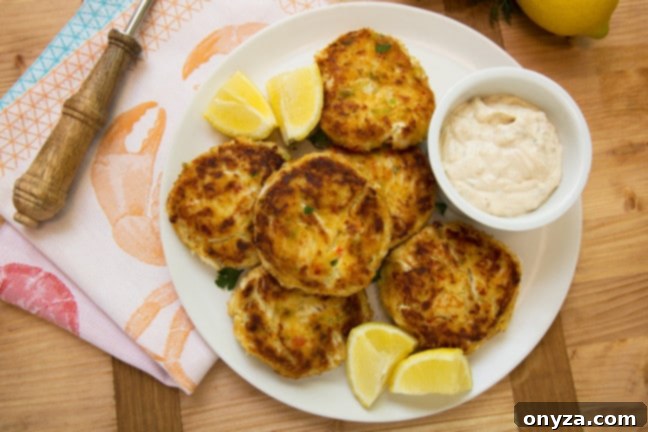Luscious crab cakes made with a pound of lump crabmeat, bound with a creamy Dijon sauce and a light coating of Panko. Great with a dollop of remoulade!

The Ultimate Roux Crab Cakes: A Recipe for Perfection
For any true food enthusiast, the journey through culinary preferences is often paved with strong opinions and passionate discussions. After years of exploring various dishes, I’ve come to realize that few foods inspire as much debate and regional variation as the humble crab cake. From the coastal towns of Maryland to the bayous of Louisiana, every region boasts its “best” version, often with conflicting techniques and ingredient philosophies.
My own quest for the “perfect” crab cake has been a delicious one, leading me to appreciate the vast spectrum of styles available. While I’ve developed an “equal-opportunity” palate for crab cakes—whether breaded, fried, baked, or broiled—a few non-negotiables consistently stand out. At the heart of any truly exceptional crab cake lies premium lump crabmeat, ideally fresh, and a commitment to minimal fillers. These principles ensure that the delicate, sweet flavor of the crab remains the star of the show.
Among my repertoire of beloved crab cake recipes, today’s feature, the **Roux Crab Cakes**, holds a special place. This recipe is my absolute go-to in the “Breaded and Fried” category, delivering a textural and flavorful experience that consistently impresses.


Crafting Culinary Excellence: What Makes These Crab Cakes Shine
Over the years, I’ve refined this recipe to highlight the inherent sweetness of a full pound of quality lump crabmeat. The secret to its incredible texture and flavor lies in a creamy, savory base infused with bright Dijon mustard and a delicate touch of sautéed aromatics. The beauty of crabmeat is its inherent deliciousness, which is why I prefer to be light-handed with additional flavors, allowing the crab to shine through with every bite.
A thin, crisp coating of Panko breadcrumbs provides a delightful contrast to the tender, moist interior. The result is a crab cake that is perfect for any occasion: a luxurious lunch, a light yet satisfying dinner, or scaled down to “cocktail-size” for elegant entertaining. I typically serve them simply, with a squeeze of fresh lemon juice, which brightens the flavors, and a generous dollop of my favorite remoulade. For variety, a classic tartar sauce or a zesty cocktail sauce also make excellent accompaniments, adding that extra “oomph.”


The Roux Revolution: Enhancing Texture and Stability
The inspiration for these Roux Crab Cakes originated over a decade ago from a recipe in the Williams-Sonoma Hors d’Oeuvre book. The original recipe used a binding mixture of whole eggs and reduced heavy cream. While the flavors were undeniably delicious, I found the cream-based binder made the cakes a touch too rich for my palate and, more critically, incredibly delicate to handle. Despite ample chilling time and a breadcrumb coating, maintaining their structural integrity in the pan proved challenging.
This challenge led to a pivotal culinary epiphany. I recalled reading about roux-based cakes, which cleverly utilize a heavy béchamel sauce as a binder. The concept was simple yet brilliant: swapping the heavy cream for an equivalent quantity of béchamel would introduce a stable, creamy binder. The results were transformative. The texture remained wonderfully creamy, but the cakes gained significantly improved stability, becoming far easier to maneuver and cook without falling apart.
With a few additional tweaks—fine-tuning the aromatics, adjusting the seasoning, and perfecting the Panko crust—I developed a crab cake recipe that quickly became a cherished summer favorite in my household. The roux not only provides a robust structure but also contributes a subtle richness that complements the crab without overpowering it, making these pan-fried crab cakes consistently perfect.



Beyond the Plate: A Culinary Life Lesson
My journey with these crab cakes isn’t just about perfecting a recipe; it’s also interwoven with memorable moments. I vividly recall one of the first times I prepared these crab cakes for friends during my senior year of college. What was meant to be an elegant “dinner soiree” almost turned into a culinary catastrophe! Unbeknownst to me, my ancient electric stove decided to quit mid-prep, leaving my main course—sad, raw chicken breasts—staring back at me from the baking pan.
Ten years later, the feeling of dread from that evening is still palpable. Thank goodness for a platter of these perfectly cooked crab cakes and a friend’s delicious coconut cake for dessert! Otherwise, we would have been ordering emergency pizza. It was a classic “live, learn, and eat crab cakes whenever possible!” kind of night, solidifying their place not just as a favorite dish, but as a culinary safety net.
Now, let’s dive into the detailed recipe for these incredible Roux Crab Cakes.

Roux Crab Cakes
by Amanda Biddle
Luscious crab cakes made with a pound of lump crabmeat, bound with a creamy Dijon sauce and a light coating of Panko. Great with a dollop of remoulade!
Inspired by Brigit Binns, “Crab Cakes” (Williams-Sonoma Hors d’Oeuvre, 2001)
Prep Time: 1 hour 10 minutes
Cook Time: 30 minutes
Total Time: 1 hour 40 minutes
Yields: 6 large or 12-14 cocktail-sized crab cakes
Ingredients
- 3 tablespoons unsalted butter, divided
- ¼ cup finely chopped celery stalks
- 2 tablespoons thinly-sliced scallions
- 2 tablespoons finely chopped red bell pepper
- 2 tablespoons all-purpose flour
- ½ cup milk
- 1 large egg yolk, lightly beaten
- 1-1/2 tablespoons Dijon mustard
- ½ teaspoon kosher salt
- ¼ teaspoon ground white pepper
- 1 pound lump crabmeat, drained well and picked over for cartilage
- ¾ cup plain breadcrumbs*
- 2 tablespoons olive oil
- Lemon wedges, for serving
- Pickapeppa Remoulade, for serving
Instructions
- Melt 2 tablespoons butter in a medium saucepan or sauté pan until foaming subsides. Add celery, scallions, and bell pepper, and sauté until just beginning to soften, about 2 minutes. Stir in flour and cook over medium heat for 1-2 minutes. Slowly whisk in milk and cook, stirring, until very thick and pulling away from sides and bottom of pan, about 2 minutes. Remove from heat and let stand 1 minute. Gradually whisk in egg yolk, followed by Dijon mustard, salt, and pepper. Let mixture cool for 5 minutes.
- Fold crabmeat into the sauce, gently breaking up the lumps, but leaving some large pieces intact. Shape into 6 cakes (roughly, 1/3-cup each), and coat with breadcrumbs. Cover and refrigerate for at least 1 hour, and up to 3 hours.
- Heat olive oil and remaining 1 tablespoon butter in a 12-inch sauté pan until foaming subsides. Cook crab cakes about 4 minutes per side until golden brown and heated throughout, using a thin spatula to gently flip. Serve hot with a squeeze of lemon juice and a dollop of remoulade, if desired.
Notes
*I love the extra crunch of Panko bread crumbs, but find the texture of most brands too coarse for these crab cakes. So, I like to give the Panko a few pulses in the food processor before breading for a finer consistency. Alternately, you can add them to a zip-top bag, seal, and crush them with a rolling pin.
Nutrition Estimate
Calories: 244kcal | Carbohydrates: 13g | Protein: 17g | Fat: 13g | Saturated Fat: 5g | Cholesterol: 81mg | Sodium: 982mg | Potassium: 225mg | Sugar: 2g | Vitamin A: 405IU | Vitamin C: 9.7mg | Calcium: 92mg | Iron: 1.4mg
Nutrition information is automatically calculated, so should only be used as an approximation.
About our recipes: Please note that our recipes have been developed using the US Customary measurement system and have not been tested for high altitude/elevation cooking and baking.
Like this recipe? We encourage you to rate and comment below! Your feedback helps us grow.
